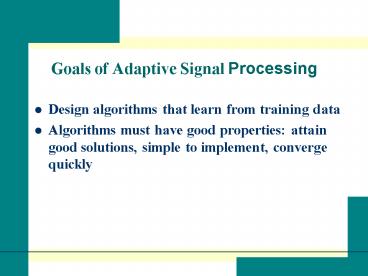Goals of Adaptive Signal Processing PowerPoint PPT Presentation
1 / 12
Title: Goals of Adaptive Signal Processing
1
Goals of Adaptive Signal Processing
- Design algorithms that learn from training data
- Algorithms must have good properties attain good
solutions, simple to implement, converge quickly
2
Learning from Examples
- Systems or filters (tap delay line) consist of
parameters or weights that are updated - Learning algorithm receives training examples
(observation data) and updates parameters of
system - Updates depend on specified criterion
- Learning can be batch or on-line
3
Tap Delay Line
x(n)
x(n-1)
x(n-2)
D
D
w0
w1
w2
X
X
X
S
y(n)
4
Tap Delay Line Parameters
- Inputs x(n)
- Delay units (two)
- Weights w ? R3
- Output y(n) w0 x(n) w1 x(n-1) w2 x(n-2)
5
Types of Learning Algorithms
- Supervised learning (learning with a teacher)
- learning algorithm receives inputs and desired
outputs - Unsupervised learning (no teacher)
- learning algorithm receives inputs
- Reinforcement learning (learning with a critic)
- learning algorithm receives inputs and an
evaluation cost or penalty, possibly delayed
6
Supervised Learning
x(n)
x(n-1)
x(n-2)
D
D
w0
w1
w2
X
X
X
e(n)
S
y(n)
S
-
d(n)
7
Supervised Learning Parameters
- Inputs x(n)
- Outputs y(n)
- Weights w
- Desired Output d(n)
- Error signal e(n) d(n) y(n)
8
Adaptive Learning System (two phases)
- Training or learning phase (equivalent to write
phase in conventional computer memory) weights
are adjusted to meet certain desired criterion. - Recall or test phase (equivalent to read phase in
conventional computer memory) weights are fixed
as system realizes some task.
9
How are weights updated?
- Iterative on-line algorithm weights of system
are adjusted on-line as training data is
received. - w(k1) L(w(k),x(k),d(k)) for supervised
learning where - d(k) is desired output.
- Cost criterion common cost criterion
- Mean Squared Error for one output J(w) ?
(y(k) d(k)) 2 - Goal is to find minimum J(w) over all possible w.
We will consider stochastic gradient based and
least squares methods.
10
Comments
- Most filters are linear time invariant filters,
but when modifying weights they become nonlinear
time varying systems - Focus on supervised on-line iterative learning
algorithms with squared error cost functions
11
Adaptive Signal Processing Problems
- System identification approximate unknown system
- Inverse modeling find a model for inverse system
for unknown noisy plant, equalization - Prediction predict value of a noisy random
signal, time series (financial, biological) - Interference cancellation cancel unknown
interference, noise cancellation and adaptive
beamforming
12
Applications
- Adaptive equalization remove intersymbol
interference, (data transmission) - Speech coding (linear predictive coding), speech
analysis and synthesis - Spectrum analysis estimate spectrum of signal in
noise based on time series data - Adaptive noise cancellation adaptive echo
cancellers - Adaptive beamforming signals arranged spatially,
adaptive antenna arrays, cancel sidelobes

